day 3 形容词与副词
- 格式:docx
- 大小:14.80 KB
- 文档页数:2

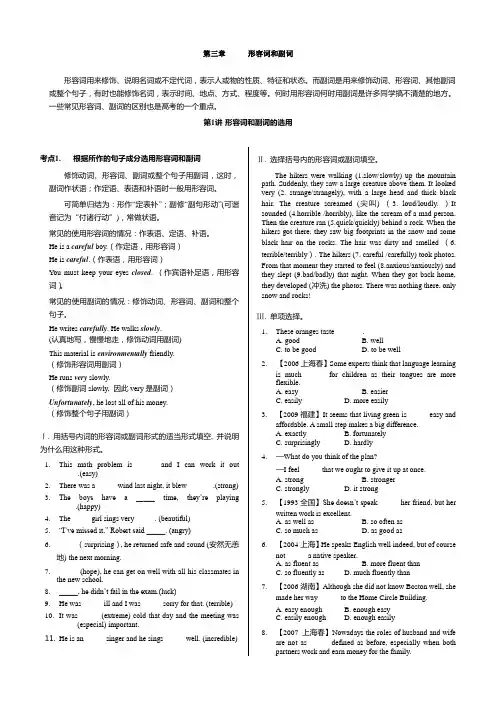
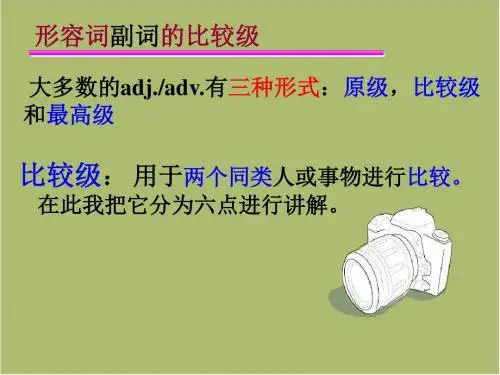
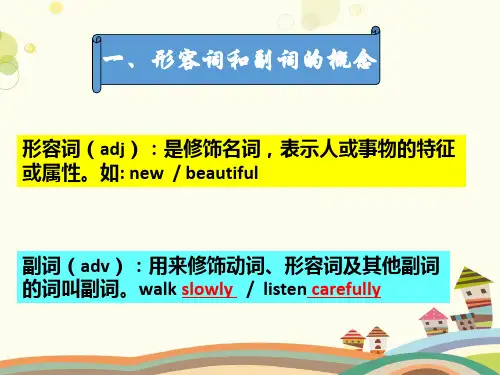


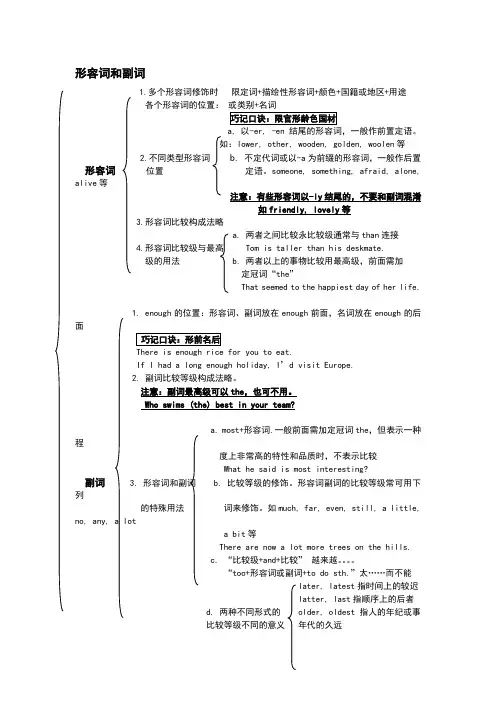
形容词和副词1.多个形容词修饰时限定词+描绘性形容词+颜色+国籍或地区+用途各个形容词的位置:或类别+名词a, 以-er, -en结尾的形容词,一般作前置定语。
如:lower, other, wooden, golden, woolen等2.不同类型形容词 b.不定代词或以-a为前缀的形容词,一般作后置形容词位置定语。
someone, something, afraid, alone, alive等注意:有些形容词以-ly结尾的,不要和副词混淆如friendly, lovely等3.形容词比较构成法略a. 两者之间比较永比较级通常与than连接4.形容词比较级与最高 Tom is taller than his deskmate.级的用法 b. 两者以上的事物比较用最高级,前面需加定冠词“the”That seemed to the happiest day of her life.1. enough的位置:形容词、副词放在enough前面,名词放在enough的后面There is enough rice for you to eat.If I had a long enough holiday, I’d visit Europe.2. 副词比较等级构成法略。
注意:副词最高级可以the,也可不用。
Who swims (the) best in your team?a. most+形容词.一般前面需加定冠词the,但表示一种程度上非常高的特性和品质时,不表示比较What he said is most interesting?副词 3. 形容词和副词 b. 比较等级的修饰。
形容词副词的比较等级常可用下列的特殊用法词来修饰。
如much, far, even, still, a little, no, any, a lota bit等There are now a lot more trees on the hills.c. “比较级+and+比较”越来越。
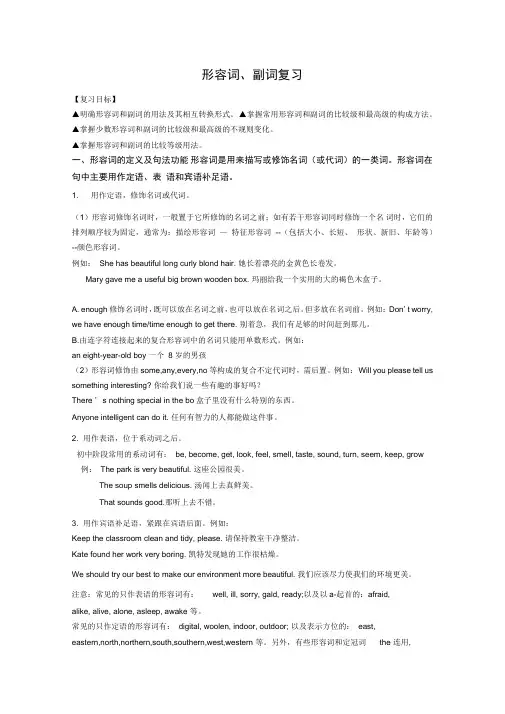
形容词、副词复习【复习目标】▲明确形容词和副词的用法及其相互转换形式。
▲掌握常用形容词和副词的比较级和最高级的构成方法。
▲掌握少数形容词和副词的比较级和最高级的不规则变化。
▲掌握形容词和副词的比较等级用法。
一、形容词的定义及句法功能形容词是用来描写或修饰名词(或代词)的一类词。
形容词在句中主要用作定语、表语和宾语补足语。
1. 用作定语,修饰名词或代词。
(1)形容词修饰名词时,一般置于它所修饰的名词之前;如有若干形容词同时修饰一个名词时,它们的排列顺序较为固定,通常为:描绘形容词—特征形容词--(包括大小、长短、形状、新旧、年龄等)--颜色形容词。
例如:She has beautiful long curly blond hair. 她长着漂亮的金黄色长卷发。
Mary gave me a useful big brown wooden box. 玛丽给我一个实用的大的褐色木盒子。
A. enough 修饰名词时,既可以放在名词之前,也可以放在名词之后。
但多放在名词前。
例如:Don't worry, we have enough time/time enough to get there. 别着急,我们有足够的时间赶到那儿。
B.由连字符连接起来的复合形容词中的名词只能用单数形式。
例如:an eight-year-old boy 一个8 岁的男孩(2)形容词修饰由some,any,every,no 等构成的复合不定代词时,需后置。
例如:Will you please tell us something interesting? 你给我们说一些有趣的事好吗?There ' s nothing special in the bo盒子里没有什么特别的东西。
Anyone intelligent can do it. 任何有智力的人都能做这件事。
2. 用作表语,位于系动词之后。
初中阶段常用的系动词有:be, become, get, look, feel, smell, taste, sound, turn, seem, keep, grow 例:The park is very beautiful. 这座公园很美。

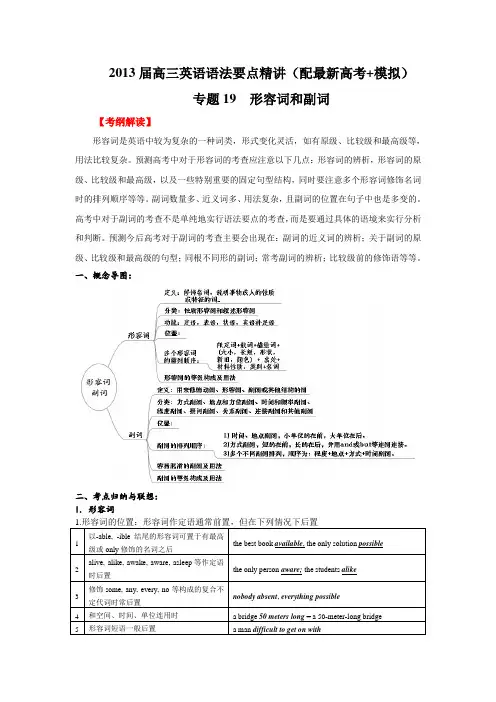
2013届高三英语语法要点精讲(配最新高考+模拟)专题19 形容词和副词【考纲解读】形容词是英语中较为复杂的一种词类,形式变化灵活,如有原级、比较级和最高级等,用法比较复杂。
预测高考中对于形容词的考查应注意以下几点:形容词的辨析,形容词的原级、比较级和最高级,以及一些特别重要的固定句型结构,同时要注意多个形容词修饰名词时的排列顺序等等。
副词数量多、近义词多、用法复杂,且副词的位置在句子中也是多变的。
高考中对于副词的考查不是单纯地实行语法要点的考查,而是要通过具体的语境来实行分析和判断。
预测今后高考对于副词的考查主要会出现在:副词的近义词的辨析;关于副词的原级、比较级和最高级的句型;同根不同形的副词;常考副词的辨析;比较级前的修饰语等等。
一、概念导图:二、考点归纳与联想:I. 形容词1.形容词的位置:形容词作定语通常前置,但在下列情况下后置1 以-able, -ible结尾的形容词可置于有最高级或only修饰的名词之后the best book available, the only solution possible2 alive, alike, awake, aware, asleep等作定语时后置the only person aware; the students alike3 修饰some, any, every, no等构成的复合不定代词时常后置nobody absent, everything possible4 和空间、时间、单位连用时 a bridge 50 meters long = a 50-meter-long bridge5 形容词短语一般后置 a man difficult to get on with6 enough修饰名词时能够前置也能够后置,但修饰形容词或副词时要后置Students brave enough to take his adventure course willcertainly learn a lot of useful skills.2.复合形容词的构成1 形容词+名词+ed kind-hearted 6 名词+形容词world-famous2 形容词+形容词dark-blue 7 名词+现在分词peace-loving3 形容词+现在分词ordinary-looking 8 名词+过去分词snow-covered4 副词+现在分词hard-working 9 数词+名词+ed three-egged5 副词+过去分词newly-built 10 数词+名词twenty-year3.形容词(短语)作伴随状语As he looked at the goat, it rolled over,dead.Afraid of difficulties, they prefer to take the easy road.With so many problems to solve, he lay in bed awake all night long.II.副词的分类:1 时间副词soon, now, early, finally,once, recently5频度副词always, often, frequently, seldom,never2 地点副词here, nearby, outside,upwards, above6疑问副词how, where, when, why3 方式副词hard, well, fast, slowly,excitedly, really7连接副词how, when, where, why, whether,however, meanwhile4 水准副词almost, nearly, very, fairly,quite, rather8关系副词when, where, whyIII. 形容词和副词的比较等级形容词和副词的比较等级分为原级,比较级和最高级。
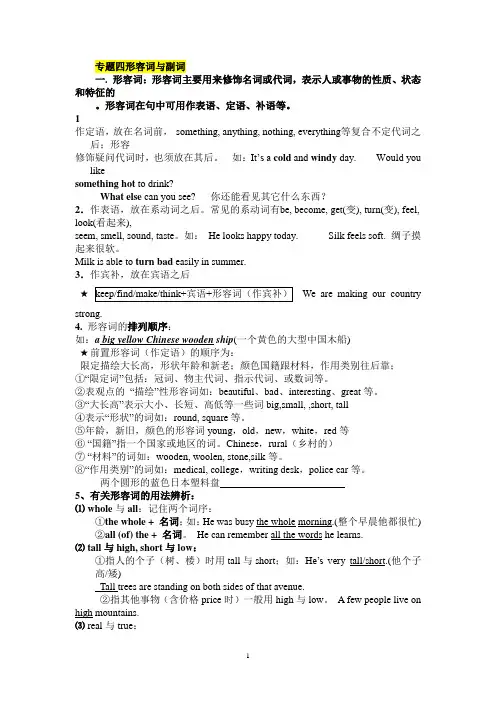
专题四形容词与副词一. 形容词:形容词主要用来修饰名词或代词,表示人或事物的性质、状态和特征的。
形容词在句中可用作表语、定语、补语等。
1作定语,放在名词前,something, anything, nothing, everything等复合不定代词之后;形容修饰疑问代词时,也须放在其后。
如:It’s a cold and windy day. Would you likesomething hot to drink?What else can you see? 你还能看见其它什么东西?2.作表语,放在系动词之后。
常见的系动词有be, become, get(变), turn(变), feel, look(看起来),seem, smell, sound, taste。
如:He looks happy today. Silk feels soft. 绸子摸起来很软。
Milk is able to turn bad easily in summer.3.作宾补,放在宾语之后★We are making our country strong.4.形容词的排列顺序:如:a big yellow Chinese wooden ship(一个黄色的大型中国木船)★前置形容词(作定语)的顺序为:限定描绘大长高,形状年龄和新老;颜色国籍跟材料,作用类别往后靠;①“限定词”包括:冠词、物主代词、指示代词、或数词等。
②表观点的“描绘”性形容词如:beautiful、bad、interesting、great等。
③“大长高”表示大小、长短、高低等一些词big,small, ,short, tall④表示“形状”的词如:round, square等。
⑤年龄,新旧,颜色的形容词young,old,new,white,red等⑥“国籍”指一个国家或地区的词。
Chinese,rural(乡村的)⑦“材料”的词如:wooden, woolen, stone,silk等。
新王牌闵行校区高中王A老师资料高中英语语法知识系列形容词和副词形容词可用于作表语、定语、宾语补足语、状语等;副词也可以作表语、定语、宾语补足语、状语等。
一.形容词作定语时的位置大部分形容词作定语时放在所修饰的名词前面, 如 a red bus, a beautiful park, cold weather等, 但实际运用时须注意以下情况。
1.当多个形容词修饰一个名词时应该注意形容词的一般排列顺序。
“限数描大小、形龄新旧色、国材用途类”例如:his beautiful small round old brown French wooden writing table当然,在实际运用中用如此多的形容词修饰一个名词并不多见。
2.形容词修饰everything, something, anything, nothing时, 只能放在其后面。
如:Some farmers saw something strange in the sky.There is nothing interesting at all.3.else只能修饰疑问代词who, whom, whose, what和不定代词something, anything, nothing, somebody, someone, anybody, anyone和nobody, no one.而且只能放在其后。
如: Is there anything else you want to say? What else do you want?else与上述疑问代词和不定代词构成所有格时, 只能在else后加's, 而不能在疑问代词或不定代词后加's. 如说someone else's, 而不能说someone’s else;who else的所有格有两种形式who else's或whose else例如:— Is this hat yours? — Whose else ( =Who else's) could it be ?4.enough和nearby作形容词时可放在所修饰的名词前,也可放在其后。
英语语法形容词和副词的比较级导语:英语学习有没有规律?学到何种水准才能算学好?英语学习需要哪些系统要素?###整理了英语学习的一些资料,欢迎阅读。
一、形容词的比较级1、形容词比较级在句子中的使用:两个事物或人的比较用比较级,比较级后面一般带有单词than。
比较级前面能够用more,alittle来修饰表示水准。
than后的人称代词用主格。
2.形容词加er的规则:⑴一般在词尾加er;⑵以字母e结尾,加r;⑶以一个元音字母和一个辅音字母结尾,应双写末尾的辅音字母,再加er;⑷以辅音字母+y结尾,先把y变i,再加er。
3.不规则形容词比较级:good-better,beautiful-morebeautiful二、副词的比较级1.形容词与副词的区别⑴在句子中形容词一般处于名词之前或be动词之后⑵副词在句子中最常见的是处于实义动词之后2.副词比较级的变化规则基本与形容词比较级相同练习一)、写出下列形容词或副词的比较级old__________young________tall_______long________ short________strong________big________small_______fat_________thin__________heavy______light________ nice_________good_________beautiful__________________ low__________high_________slow_______fast________late__________early_________far_________well_______二)、根据句意填入单词的准确形式:1.Mybrotheristwoyears__________thanme.2.Tomisas________asJim.3.Isyoursister__________thanyou?Yes,sheis.4.Whois___________,youorHelen?Helenis.5.Whosepencil-boxis__________,yoursorhers?Hersis.6.Maryshairisas__________asLucys.7.Ben______________thansomeoftheboysinhisclass.8.________Nancysing__________thanHelen?Yes,she_____.9.Fangfangisnotas_________astheothergirls.10.Myeyesare__________than________..11.Whichis___________,theelephantorthepig?12.Whogetsup_________,TimorTom?13._____thegirlsgetup_______thantheboys?No,they______.14.Jimruns_____.ButBenruns_____.15.Thechilddoesnt______as____asthestudents.三)、翻译句子:1、谁比Jim年纪大?是你。
形容词和副词的用法形容词和副词都是起修饰作用的词,形容词修饰名词和代词。
副词修饰动词,形容词和其他副词或整个句子。
一形容词的构成1 本身是形容词。
如:good,happy等。
2 由名词加y构成:sun—sunny,wind—-windy,rain——rainy,flower—-flowery.3.由名词+-able,+-ent,+-en,+-al,+-less,+-ful,+-ing,+-ive,等构成,如:comfort—comfortable,differ—different,nation—national, wood—wooden, care—- careful,care—careless, excite—-exciting, act—-active.4.由名词+ly构成形容词,如:friendly,lonely, lovely,lively,likely,ugly,brotherly, motherly,fatherly,daily,weekly,monthly,yearly,early,manly,orderly,deadly,等。
5 复合形容词如:kind-hearted,warm-hearted,well-educated,good-looking,man-made,Harding-working,peace-lovin g,new-born, snow-white,duty-free.二形容词的作用1 做定语修饰名词和代词a good boy,something new,等。
2 做表语,He is happy.3 作宾语补足语I found him hard-working.4 作主语补足语He was found hard-working.(被动语态中)5 做主语或宾语(前面加the)The new replaces the old.新事物代替旧事物。
6伴随状语Tired and hot, we have to stop to have a rest.三形容词的位置1 放在所修饰的名词前,a red coat.2 放在不定代词的后面something important.3 长宽高深等形容词放在数词+名词的后面,如:five meters high/deep/wide/long, six years old,4 enough 放在形容词和副词之后,名词前后均可。
初中英语形容词和副词讲解与专项练习题
一形容词
(一)定义用来描写或修饰名词或代词,说明人或事物的特征或性质。
(二)用法
1.做定语。
e.g. This is an old house.
2.做表语。
e.g.I am sorry to hear that.
3.做宾语不足语。
e.g.She made her mother angry.
4.形容词在句中的位置。
形容词做定语修饰名词时,放在名词前面。
修饰不定代词时要放在不定代词
之后。
e.g.
She is a clever girl.
I saw something white in the water.
形容词修饰带有表量度的词或者词组时定语后
置。
The bridge is one hundred meters long .
5.某些形容词前加上定冠词the,可以代表一类人或东西,可以用作主语,宾语等。
做主语时当复数看待。
e.g.The old are well looked after.
二副词
(一)定义用来修饰动词,形容词,其他副词以及全句。
(二)用法 1.作状语。
e.g.
They work hard.
三形容词和副词的比较等级
(一)形容词和副词的比较级和最高级变化
1.规则变化单音节词和部分双音节词
1)一般在词尾加er,est. hard---harder---hardest great---greater---greatest
(2)以字母e结尾的加r,st. nice---nicer----nicest able---abler----ablest
(3)重读闭音节中末尾只有一个辅音字母时,双写辅音字母,再加er,est. big---bigger---biggest fat---fatter---fatter red---redder---reddest
多音节词和部分双音节词,在其前加more, most.
interesting-more interesting-most interesting
carefully--more carefully--most carefully
quickly--more quickly--most quickly happily--more happily--most happily
有些形容词和副词的比较等级用-er,-est或者more, most皆可,如clever, lovely 等。
表示“较不---”和“最不----”时,可用less和least. difficult---less difficult---least difficult interesting---less interesting---least interesting
2.不规则变化形
good better best well better best
bad/ill worse worst
many/much more most
little less least far farther/further farthest/furthest far farther/further farthest/furthest
old older/elder oldest/eldest
(二)形容词和副词级的用法原级:
(1)原级的基本用法
句型:主语+谓语动词+as+原级+as+比较对象 The coat is as old as that one .
(2)原级的特殊用法
1)表示"是....的几倍". 句型: .....times +as +原
级 + as ..... This house is three times as largeas that one .
2)表示"...的一半...". 句型: .....half as +原
级 + as ... My money is not half as much as yours.
3)表示"尽可能......". 句型: .....as + 原级 + as possible/one can.
We should get up as early as possible/we can.。